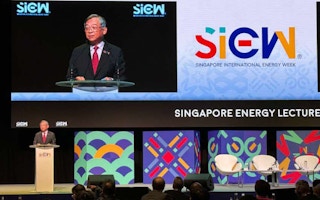Singapore is studying the suitability of advanced atomic power hardware such as small reactors that have been touted as safer, cheaper and faster to build.
The city-state will work with other countries to learn more about the technology, which Singapore is “closely monitoring”, said trade and industry minister Gan Kim Yong.
The statement is yet another signal of the city-state’s growing interest in atomic power as pressure builds for countries to find low-carbon alternatives to fossil fuels to power their economies. Asian nations have shown particular interest in nuclear, even as some traditional users in the West are moving away from it.
Gan stopped short of committing Singapore to leveraging the power source.
“Let me be clear – Singapore has not made any decision to deploy nuclear energy,” he told the audience at the Singapore International Energy Week conference.
Nuclear power generation produces almost no greenhouse emissions, but remains controversial due to radiation risks, geopolitical concerns and public fear of the fall-out caused by nuclear accidents.
Gan noted that small modular reactors could be safer than the conventional large-scale units used today because some of the new designs can cool passively without requiring external systems or human input during emergencies.
Small nuclear reactors generally have generation capacities under 300 megawatts – about half that of typical gas-fired power plants in operation today. In contrast, nuclear plants built in past decades were often gigawatt-scale.
“We must keep our options open and stay abreast of promising solutions,” Gan said on Singapore’s future energy mix.
Singapore has long been studying nuclear power generation and safety, but had said in 2012 that technologies then were not suitable for Singapore.
Last year, a government scenario-planning paper said the city-state could tap on nuclear power for about a tenth of its 2050 electricity needs, should other low-carbon options develop too slowly and if countries cannot find ways to work together on decarbonisation.
Slow progress
Singapore is currently moving “far slower than expected” if it wants to have nuclear power available in its 2050 power mix, said Dr Victor Nian, chief executive of Singapore-based think tank Centre for Strategic Energy and Resources.
The first small nuclear reactors could take around 10 years to build, Nian estimated, including getting in place the requisite regulation and supporting infrastructure, such as development sites and electricity grid connections.
“What we are critically missing is in-depth knowledge and expertise in nuclear energy, as well as a sustainable talent pool in the broad field of nuclear energy,” Nian said.
There are also risks in having to build a nuclear plant possibly near population clusters in urban Singapore, and in handling spent fuel and radioactive waste. But if used safely, nuclear fuel is a denser source of energy than fossil fuels and renewables, and more power can be produced with a smaller footprint, Nian noted.
The city-state is also open to importing nuclear power from its neighbours, though any actual cross-border nuclear power trading appears extremely unlikely in the near-term, as Southeast Asia currently only has one commercial-scale facility in the Philippines which has never been switched on.
The Philippines, along with Indonesia and Vietnam, are among countries also studying the use of small nuclear reactors.
American firm NuScale Power revealed plans this year to build such reactors in both Indonesia – which wants its first plant operational by 2040 – and the Philippines. The United States has funded Indonesia’s efforts in building a facility on Borneo island, while China has also offered assistance to the Philippines.
However, public support remains low over nuclear power. An end-2021 study in Singapore found 20 per cent of its citizens in favour of the technology, compared to 39 per cent in Indonesia and 3 per cent in Thailand.
Recently, Japan caused consternation from its neighbours by releasing treated wastewater from its crippled nuclear plants in Fukushima, 12 years after their reactors melted down after an earthquake and tsunami.
Nuclear key for net-zero: IAEA
Nuclear power capacity worldwide fell 10 gigawatts in the past year, as plant retirements outpaced new capacity, US-based analyst Global Energy Monitor said last week. Germany closed its last nuclear power plant this year, despite having some 20 gigawatts of capacity in the 1990s.
Speaking at the energy conference in Singapore, Dr Mikhail Chudakov, deputy director-general of the International Atomic Energy Agency, called for a rapid scale up of nuclear power instead.
“I’m not in a position to criticise other [energy] sources but … I strongly believe that without nuclear power, we cannot seriously get to net-zero by 2050,” he said, pointing to the technology’s long lifespan and high power generation capacity.
Chudakov said the newer, smaller reactors apply well to countries like Indonesia and the Philippines, each of which is made up of thousands of islands, making larger connected grids a challenge.
“We hear the [people in the region] not talking too much [about nuclear power], it looks like it is shameful to talk about nuclear power,” he said.
Speaking with Eco-Business, Chudakov conceded that Southeast Asia still lacks the sort of deep geological storage sites for safely disposing of nuclear waste that are being built in Finland and Sweden.
Chudakov added that it is likely each country in the region needs to handle their own radioactive waste. There have been past attempts in the West to develop regional disposal hubs, but fierce opposition had stalled these efforts. Countries such as the United States and France store nuclear waste on-site at power plants and in purpose-built storage pools.
Nonetheless, there are ongoing attempts to re-purpose radioactive waste into new fuels, in a concept termed a “closed fuel cycle”, Chudakov noted.
Correction note: Paragraphs 13 and 14 have been edited for clarity.

















